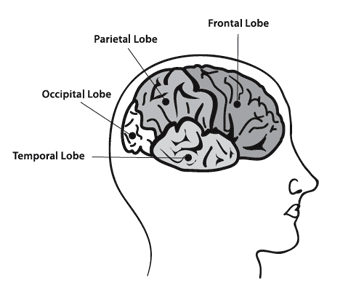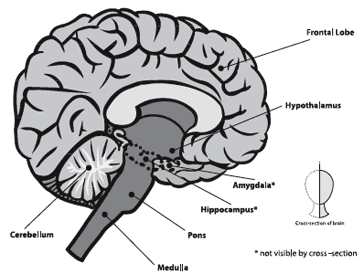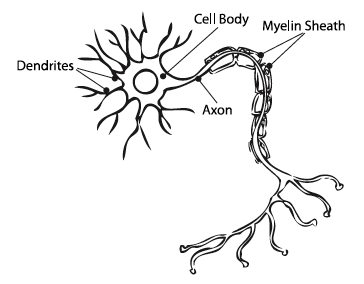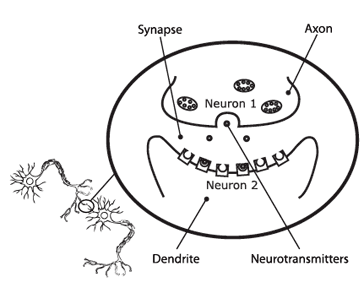

|
|
Module 1
An Introduction to the Brain and Nervous System
Background
MAJOR PARTS OF THE BRAIN
Cerebral Cortex
The cerebral cortex is the largest part of the human brain, making up more than 75 percent of this organ. The cerebral cortex is also the most highly developed part of the brain. It controls thinking, perception, and understanding language.
The cerebral cortex is divided into two hemispheres - the right hemisphere and the left hemisphere.
- The right hemisphere controls the left side of the body and is largely responsible for artistic expression and for understanding relationships in space - tasks such as reading a map.
- The left hemisphere controls the right side of the body. It is largely responsible for mathematical ability, problem solving, and comparing information needed to make decisions. It is also the brain's language center.
The two hemispheres communicate with one another through a bundle of fibers called the corpus callosum. The corpus callosum is the bridge between the two hemispheres.
The cortex is specialized. Four specific areas of the cortex, called lobes, are responsible for different tasks:
- The frontal lobe is responsible for initiating and coordinating motor movements and higher cognitive skills, such as problem solving and thinking.
- The parietal lobe processes sensory information from the whole body - for example, information
about pain, touch, and pressure.
- The occipital lobe processes visual information coming into the brain.
- The temporal lobe is in charge of making sense of the auditory information from the environment.

Hypothalamus
The hypothalamus is situated deep inside the center of the brain. The hypothalamus links the nervous system to the endocrine system by producing and releasing hormones. The endocrine system is made up of glands that regulate, coordinate, and control hormones. The hypothalamus regulates body temperature, hunger, and thirst.
Cerebellum
The cerebellum is located at the back of the head near the spine. It controls posture, movement, and the sense of balance. Playing ball, picking up objects, and playing musical instruments are among the activities that fall under the control of the cerebellum.
Brain Stem
The brain stem, the most primitive part of the brain, connects the brain to the spinal cord. It is located near the cerebellum. The two main parts of the brain stem are the pons and the medulla. The pons contains nerve fibers that connect the cerebral cortex with the cerebellum and the spinal cord. The pons controls sleep, awakening, and dream onset. The medulla controls heart rate, respiration, and blood pressure. The brain stem also controls simple reflexes, such as coughing and sneezing.
Limbic System
The limbic system is located deep inside the brain. It has many parts, but two of the most important are the hippocampus and the amygdala. The hippocampus is mainly responsible for learning and memory. The amygdala plays an important role in emotional behavior. The limbic system is greatly affected by substances such as nicotine, alcohol, and illegal drugs.

NEURONS
Information is constantly exchanged between the brain and other parts of the body by both electrical and chemical impulses. Cells called neurons are responsible for carrying this information. All of the major brain parts discussed above are composed of neurons - almost 100 billion neurons total!
A neuron has three main parts. The cell body directs all the neuron's activities. Dendrites, short branches that extend out from the cell body, receive messages from other neurons and pass them on to the cell body. An axon is a long fiber that transmits messages from the cell body to the dendrites of other neurons or to other tissues in the body, such as muscles. A protective covering, called the myelin sheath, covers the axons of many neurons. Myelin insulates the axons and helps messages from nerve signals travel faster, farther, and more efficiently.

NEUROTRANSMISSION
The exchange of information between the axon of one neuron and the dendrites of another neuron is called neurotransmission. Neurotransmission takes place through the release of chemicals into the space between the axon of the first neuron and the dendrites of the second neuron. These chemicals are called neurotransmitters. The space between the axon and the dendrite is called a synapse.

When neurons communicate, an electrical impulse traveling down the axon causes neurotransmitters to be released from the end of the axon into the synapse. The neurotransmitters cross the synapse and bind to special molecules, called receptors, on the dendrite of the second neuron. Receptors are found on the dendrites and cell bodies of all neurons. The receptors convert the information into chemical or electrical signals which are then transmitted to the cell body and eventually to the axon. The axon then carries the signal to another neuron or to body tissues such as muscles.
Once a neurotransmitter binds to a receptor, a series of events follow. First, the message carried by the neurotransmitter is passed on to the receiving neuron. Second, the neurotransmitter is inactivated. It is either broken down by an enzyme or reabsorbed by the axon from which it was released. Other molecules, called transporter molecules, complete this reabsorption process. These molecules are located in the cell membranes of the axon that releases the neurotransmitters. They pick up specific neurotransmitters from the synapse and carry them back across the cell membrane and into the axon, where they are recycled for use at a later time. Note that this process is true for most neurotransmitters, but not for all of them.
The human body produces many different types of neurotransmitters. Each neurotransmitter has a specific role to play in the functioning of the brain. A neurotransmitter binds to a receptor in much the same way that a key fits into a lock; a specific neurotransmitter will bind only to its corresponding receptor.
Neurotransmitter messages can be generalized as either excitatory or inhibitory messages. An excitatory neurotransmitter is one that increases the activity of neurons, and an inhibitory neurotransmitter decreases the activity of neurons. Over the course of these modules, several specific neurotransmitters will be discussed, including acetylcholine, GABA, and dopamine.
| Neurotransmitter |
Brain Function |
| Acetylcholine (excitatory) |
Plays an important role in the function of the hippocampus, which is in charge of learning and memory. |
| GABA (inhibitory) |
A neurotransmitter in the cerebral cortex, which controls thinking, perceiving, and understanding language. |
| Dopamine (excitatory) |
Plays an important role in the pleasure/reward system in the brain. |
|